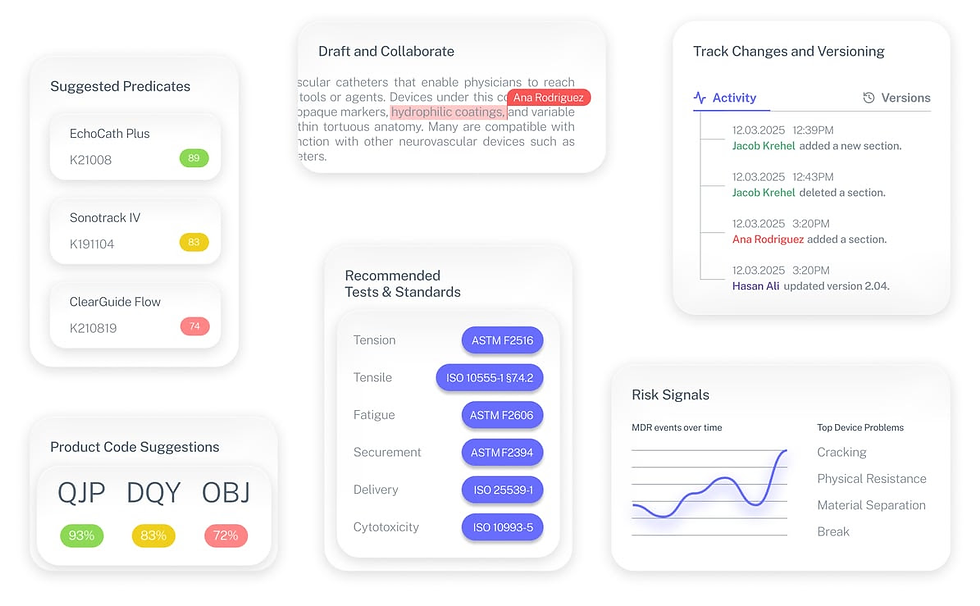Post-Market Surveillance for Medical Devices: Ensuring Ongoing FDA Compliance
- Beng Ee Lim

- Oct 31, 2024
- 4 min read
Updated: Sep 7
FDA postmarket surveillance means monitoring safety, investigating complaints, filing MDRs within 30 days (or 5-day in certain cases), reporting corrections/removals within 10 working days, maintaining UDI/GUDID and, when ordered, device tracking, and completing 522 or post-approval studies when required. Use this guide to set up the workflows and deadlines that keep you compliant.

What is Post-Market Surveillance (PMS)?
Post-Market Surveillance (PMS) is the systematic monitoring of a medical device's performance, safety, and effectiveness after it receives FDA clearance. PMS is vital for tracking any adverse events, malfunctions, or compliance issues that might emerge during real-world use.
By adhering to PMS requirements, companies can detect any potential risks early, allowing them to initiate corrective measures, protect patients, and avoid regulatory actions.
Why Post-Market Surveillance is Essential for FDA Compliance
The FDA expects continuous post-market monitoring to identify and manage potential safety or performance issues. Through PMS, companies can ensure their devices meet ongoing compliance standards, prevent adverse events, and maintain public trust.
Ongoing PMS helps companies:
Identify and address issues early: Early detection enables companies to address malfunctions before they impact patient safety.
Maintain device quality: Consistent monitoring ensures that devices perform as intended over time.
Comply with regulatory expectations: Adhering to PMS requirements minimizes the risk of FDA penalties or recalls.
Key FDA Requirements for Post-Market Surveillance
Medical Device Reporting (MDR) Requirements
Under MDR requirements, companies must report any adverse events or device malfunctions to the FDA within a specific timeframe. MDR submissions document incidents where a device may have contributed to injury or malfunction, enabling the FDA to track and investigate issues.
Key MDR Components:
Incident reporting: Any event that leads to serious injury, death, or malfunctions must be reported.
Timely submissions: Reports must be submitted within 5 to 30 days, depending on the severity.
5 days for device-related deaths or serious injuries.
30 days for other reportable events, such as device malfunctions that could likely contribute to serious outcomes if they recur.
Post-Approval Studies and Periodic Reporting
For certain high-risk devices, the FDA may mandate post-approval studies (PAS) to gather additional data on long-term safety and effectiveness. Companies must also submit periodic reports summarizing post-market data, providing the FDA with continuous updates on device performance.
Corrective and Preventive Actions (CAPA)
CAPA requirements ensure that companies address any compliance issues or deviations. CAPA processes are used to investigate and correct root causes of issues, helping prevent future occurrences. CAPA records must be meticulously maintained and available for FDA review.
Effective Post-Market Surveillance Practices
Monitoring and Data Collection Techniques
Implement robust monitoring systems that collect data from various sources, including clinical data, customer feedback, and complaint reports. Regular audits, quality reviews, and real-time data tracking help companies stay informed about device performance.
Clinical Data: Information gathered from clinical trials or real-world use to assess device performance.
Customer Feedback: Insights from users regarding their experiences and any issues encountered with the device.
Complaint Reports: Documentation of any adverse events or malfunctions reported by users.
Analyzing Data for Early Detection of Issues
Use data analytics to detect potential issues before they escalate. Analyzing trends in feedback or performance data helps companies identify risks early and take proactive measures to maintain compliance.
Early Issue Detection: Spotting anomalies or negative trends can prevent minor issues from developing into significant problems.
Proactive Measures: Taking corrective actions based on data analysis helps ensure ongoing safety and effectiveness of the device.
Common Post-Market Compliance Challenges and Solutions
Managing High Volumes of Data
Post-market surveillance can generate large amounts of data, making it challenging to manage and analyze. This consistency is critical for meeting regulatory expectations and facilitating audits. Solutions include:
Automated data collection: Streamlining data collection to reduce errors.
Centralized data management: Using a single platform to organize and review PMS data.
Ensuring Consistent Documentation and Reporting
Maintaining comprehensive records is essential for FDA compliance. Companies should establish standard operating procedures (SOPs) for data documentation and reporting, ensuring that all PMS activities are tracked and updated regularly.
The Fastest Path to Market
No more guesswork. Move from research to a defendable FDA strategy, faster. Backed by FDA sources. Teams report 12 hours saved weekly.
FDA Product Code Finder, find your code in minutes.
510(k) Predicate Intelligence, see likely predicates with 510(k) links.
Risk and Recalls, scan MAUDE and recall patterns.
FDA Tests and Standards, map required tests from your code.
Regulatory Strategy Workspace, pull it into a defendable plan.
👉 Start free at complizen.ai

Conclusion
Post-market surveillance is critical for maintaining FDA compliance, ensuring patient safety, and detecting performance issues before they become significant. By understanding FDA requirements, leveraging effective data monitoring, and implementing CAPA, companies can establish a proactive approach to PMS. Tools like Complizen can assist with automating PMS activities, ensuring compliance, and supporting long-term device quality.
FAQs
What is the purpose of post-market surveillance for medical devices?
PMS monitors the safety, performance, and effectiveness of a device after market approval, helping detect potential issues early and maintain regulatory compliance.
What is Medical Device Reporting (MDR)?
MDR is a requirement for reporting adverse events, malfunctions, or injuries associated with a device to the FDA, allowing for continued monitoring of device safety.
How does CAPA fit into post-market surveillance?
CAPA is part of PMS focused on identifying and addressing compliance issues. It helps companies correct problems and prevent future occurrences.
What are post-approval studies?
Post-approval studies are FDA-mandated studies for certain devices, requiring companies to collect data on long-term safety and effectiveness after market entry.
How can Complizen help with post-market surveillance?
Complizen offers tools to streamline PMS by automating data collection, organizing CAPA processes, and ensuring timely MDR reporting to support ongoing compliance.



